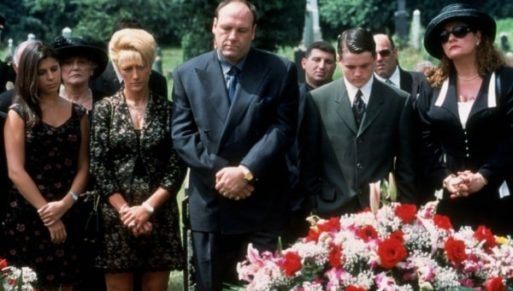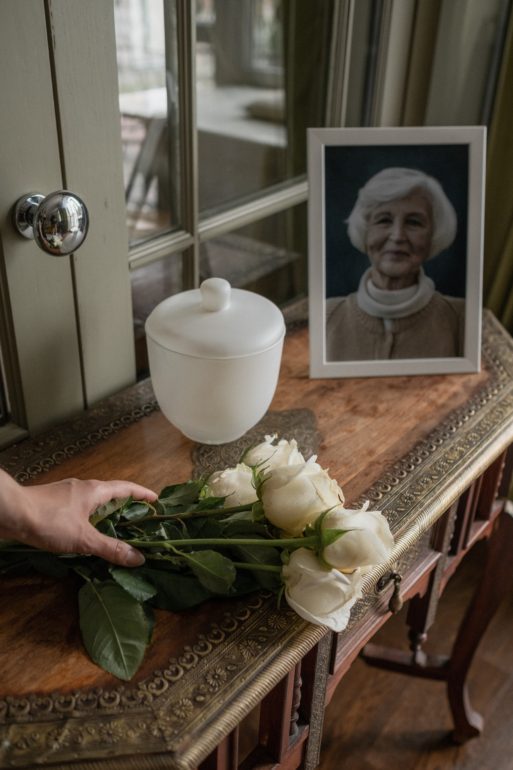
Picture it: a big, fancy funeral in a popular TV show or movie. Late-model hearses transport all of the attendees, who snark about each other while wearing Chanel and sunglasses, to a green cemetery. There, the bereaved say their good-byes to a weighty casket (sometimes in the rain) as a pale-faced preacher reads over a small Bible in front of a sea of roses.
“As soon as somebody dies,” says Josh Slocum, former Executive Director of the Funeral Consumers Alliance, “everybody is wearing a Gucci mini black dress or a Brooks Brothers suit, and they’re all driving around in Cadillacs.”
That may be the fantasy, but, as anyone who’s experienced a funeral in North America knows, that’s not necessarily the reality. In fact, cremation is actually now the #1 choice of final disposition in the United States, and its popularity is growing every year, in large part due to the cost. According to the 2021 National Funeral Directors Association General Price List, the median cost of a funeral with a viewing, burial, and vault is $9,420 while the median cost with a viewing and cremation is $6,970.
While funeral providers undoubtedly provide necessary services at some of the most difficult times in people’s lives, an over-reliance on myths and misconceptions can be needlessly expensive. SevenPonds recently sat down with Slocum and Jim Bates, President of the Funeral Consumers Alliance of North Texas, to examine what these myths (and their truths) are.

Jim Bates enjoys the sun in his home state of Texas
Credit: Jim Bates
Myth #1: You need everything the funeral director suggests.
Truth: You only need four things.
According to “The Funeral Rule” established by the Federal Trade Commission in the early 1980s, funeral providers are required to provide a General Price List to potential consumers and to follow certain guidelines when interacting with them.
These include:
- The consumer has the right to purchase only the items he/she wants to buy.
- The consumer can purchase a casket and other goods elsewhere.
- The consumer does not have to have purchase embalming for the deceased.
- Alternative containers (such as cardboard boxes) can be used instead of a casket for direct cremation (which is often the most cost-effective way to handle final disposition).
The only required cost a consumer must incur from a funeral provider is the basic services fee.
According to the FTC, that fee covers “services that are common to all funerals, regardless of the specific arrangement. These include funeral planning, securing the necessary permits and copies of death certificates, preparing the notices, sheltering the remains, and coordinating the arrangements with the cemetery, crematory, or other third parties.”
All states mandate the same paperwork when a death occurs; they also generally require the same kind of paperwork to accompany the body to the cemetery, crematory, or place of final disposition.
However the states vary in that they have different names for these documents; for instance, one state may call the document a “cremation permit” while another calls it a “crematory permit;” it’s best to check with your state to see what the proper nomenclature is.
Beyond that, per Slocum, only four things are required by law (no matter which U.S. state you live in):
- A death certificate signed by a physician, hospice director, or medical examiner. The signature makes the death legally recognized by the state and must be done before the body is buried, cremated, or otherwise disposed of.
- A burial/transit permit to accompany the body when it goes to the crematory or cemetery; this can be done once the death certificate is signed, and it states that the death has been duly recorded and now the body can be buried, cremated, or disposed of.
- While some states require an additional permit for cremation, others do not. Of the states that do, some combine the cremation permit with the burial/transit permit; of the states that do not, they may use separate forms (again, it’s best to check).
- A decision regarding burial, cremation, donation to medical school or other means (alkaline hydrolysis, for instance, is an option in some areas) within a certain timeframe. Some states require the disposition to occur within a specified number of days; others merely refer to this as a “reasonable period.”
Aside from those requirements, everything else is optional. As Slocum notes, “Why would anything else be legally required? Why would there be a law that said you had to have a ceremony? Why would there be a law that said you had to have a minister for this ceremony?”
Myth #2: I have to hire a funeral home to do everything.
Truth: No, you don’t.
As Slocum clarifies, “A sense of your rights and your options and being in control as a funeral consumer starts with understanding that you do not have to be a consumer at all.”
“Funeral directors are event planners who have a license to embalm and a license to cremate. And that’s it,” Bates says, “that’s really all there is to it. But the industry has managed to take control of everything. But if consumers don’t ask what they can do, they’ll be subjugated by the industry and everything will be done.”
Natural death care and home funerals still occur today as they have occurred throughout history. Even if someone doesn’t want to take care of all of the details at home, there are ways to participate in the process. For instance, people can take care of the body at home by washing it, dressing it, keeping it cool with ice packs, and even holding a service on the premises.

Josh Slocum serves as the Executive Director of the Funeral Consumers Alliance
Credit: Josh Slocum
Bates continues, “I highly recommend consumers say, ‘Hey, what can I do? Can I transport the body? Can I come in and wash it up? Can I cut his hair, do the fingernails. Can we pick up the body and put it in the casket? Can we have our own party space somewhere?”
Even helping out in minor ways can minimize costs and, more importantly, bring a sense of closure in the process.
Myth #3: Instead of shopping around, I should rely on my local funeral home or “my family’s place.”
The closest, or most familiar, funeral home may not be the best choice.
Most funeral homes will travel a fair distance to pick up a body, so it is in your best interest to shop around and pay a little extra for the transport.
But people often don’t shop around because it’s so ingrained in their psyche that a certain home is “their family’s place.” Or, since many people don’t live in the same hometown as their family, they may believe that the local funeral home is somehow “the best” because everyone else around them seems to use them.
But that’s not necessarily the case.
You can–and should–shop around. It’s in the funeral consumer’s best interest to compare services.
Per Bates, “Prices here in Dallas-Fort Worth Metroplex go from $699 to $6,800 for what’s called a direct cremation. And that’s a federally mandated term for what you get as a consumer. And so that’s the price range … you get the exact same thing at $6,800 as you get for $699.”
As Slocum notes, “Ask people who’ve ever planned a funeral to tell you why they chose that particular funeral home. They’re going to tell you ‘that’s the one my family uses.’ That is entirely a consumer choice, and if you overpaid by $3,000, the only person responsible for that is you.”

Cremation is becoming more of a popular choice.
Credit: Pexels
Myth #4: Only professionals should handle a dead body; that’s why funeral directors are the only ones who should deal with it.
Truth: No, you don’t need a pro.
Many people find the thought of touching a dead body distasteful or scary.
“It’s probably an evolved response, but evolved responses go wrong all the time,” says Slocum. “People believe all sorts of things about dead bodies that aren’t true. One of the big fears people think is that dead bodies make you sick…like literally with a physical ailment, but that’s not true. Dead bodies are almost never going to transmit disease.”
Before massive industrialization changed our lives and medicalization took sickness and death out of our hands, Western culture used to be more comfortable around death. In fact, before it was renamed “the living room,” the front room of a house was also called a “death room” or “parlor” where people used to hold funeral vigils for the deceased.
But since “funeral parlors” cropped up as a way of outsourcing funerary needs, the industry began promoting the “need” for embalming as a way of delaying decomposition.
“The American public thinks that every dead body must be embalmed, which is not true anywhere,” Bates elaborates. “And since the body must be embalmed, only funeral people embalm. So that’s how the whole game works. And that’s another horrible thing the funeral industry has done to the American public … They’ve made us think that a dead body is “icky.” They used to say it was a health hazard and we shouldn’t touch a dead body until they clean it up, embalm it, and get all the nasty stuff out. They’ve made us think it’s an icky thing, and it’s just not.”
If we really think about it, what’s more off-putting – a corpse in the early stages of decomposition or one that is pumped full of formaldehyde, glutaraldehyde, methanol or wetting agents that may eventually leach into groundwater?
Myth #5: The more expensive the service, the better the care.
Truth: Not at all.
In our culture, we’ve come to believe a perceived value of a good or service depends upon its price point. Businesses leverage perceived value all of the time to maximize profits, and examples flood our culture (i.e., bottled water, a four-year college degree).
The funeral industry relies upon perceived value in addition to the human tendency that people will spend more on loved ones as a way of caring for the legacy of the deceased. A study by Sarah Whitley, an assistant marketing professor at the University of Georgia, found that people will tend to spend over $1,000 more when planning for someone else’s funeral than they would for their own.

Credit: Pexels
As she notes, “What we learned is that when people are planning a funeral, their main motivation is providing care for their loved ones. But when you’re caring for someone who has already died you don’t really have this notion of caring for their material well-being. You’re caring for their memory or their legacy instead.”
But just because something has a higher price point or is intended to preserve the legacy, doesn’t mean that either the quality is superior or that intention will be realized.
“I’m ripping the Band-Aid off right now,” Slocum says, “because if I don’t rip off the Band-Aid off for you, you’re going to go down to the funeral home and tell them that you want to make sure that mom looks like Sleeping Beauty and they’re going to sell you a $5,000 bronze vault that won’t actually make mom looks like Sleeping Beauty (and you’d never know anyway.) This is not a good use of your emotional balance and it’s not a good use of your financial balance. When you bury your loved one, your loved one is going to decompose. Water is going to get in there; earth is going to get in there.”
“The standard cremation container is a cardboard box,” says Bates, “that is just about 18 inches deep, 24 inches wide, and about six-feet long. And it costs about 50 bucks.” But funeral directors are highly trained to up-sell to consumers, using gently persuasive language like “a cremation casket would be nice,” Bates explains. When the consumer agrees, “now we’re talking $2,000 instead of a $100. That’s the casket trick,” Bates says. “Or they’ll charge $500 for a $50 cremation box.”
The Antidote to Overpaying
When re-examining many of these defaults, we recognize that a lot of these preconceptions stem from the fear of the unknown and perhaps the fear of our own deaths. But the key to overcoming these fears (and not overpaying for needless expenses) is to re-examine our relationship with death and the funeral industry.
Slocum adds, “We think we’re trapped in a box when it comes to death, and the funeral industry likes it to be that way. They know we’re trapped, and it’s a cultural thing peculiar to the United States. And we in the United States do not understand that.”
Making peace with death and even participating in the death care process (as opposed to outsourcing everything) can prevent needless expenses. It can also provide a sense of peace and closure that handing a loved one’s body over to a stranger never can.
As Bates concludes, “From a psychological standpoint, the more kinetic you are during times of trouble, the better you can handle it. You’re less of a victim in that sense.”

 5 Myths About Arranging Funerals Debunked
5 Myths About Arranging Funerals Debunked


 Our Annual Seven Holiday Gifts for Someone Who Is Grieving, 2024 Edition
Our Annual Seven Holiday Gifts for Someone Who Is Grieving, 2024 Edition
 “Making Mobiles” by Karolina Merska
“Making Mobiles” by Karolina Merska
 “Hands Up to the Sky” by Michael Franti & Spearhead
“Hands Up to the Sky” by Michael Franti & Spearhead














